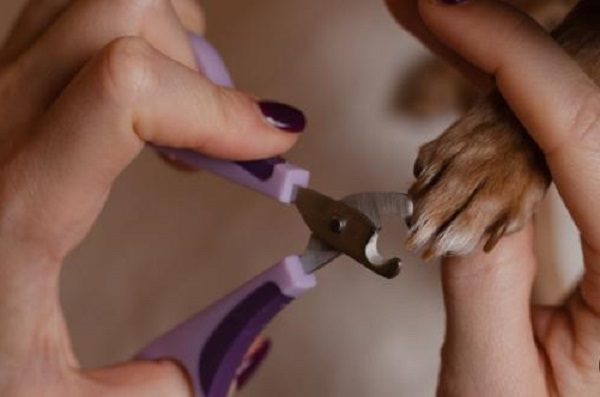Start learning how to properly trim your dog’s nails with our in-depth article, “How to Safe dog nail trimming: A Step-by-Step Guide for Pet Owners.” This necessary grooming ability is not only a regular aspect of maintenance, but it’s also critical to the comfort and welfare of your dog. Take a look at our easy-to-follow, step-by-step method, which includes Dipako’s help, to make nail cutting easy and stress-free for you and your cherished pet. Goodbye to the difficulties associated with nail maintenance and hello to a more contented and robust dog!

Creating Comfort for Your Dog

When it comes to grooming tasks like nail clipping, it’s critical to establish your dog’s comfort level. Start by giving your dog a sense of security from the beginning by holding their paws with gentleness and care. Introduce the noises that go along with using the grooming and trimming instruments to them. Go around your dog’s toes with the clippers to gradually adapt them to the feeling. Given the possibility that these behaviors might cause anxiety, provide your dog with mouthwatering dog training treats to help keep them relaxed and interested. Using positive reinforcement to provide a pleasant and comfortable grooming experience, it’s important to develop the habit of rewarding your dog at each of these steps.
What You’ll Be Needing
To ensure a smooth and effective nail-cutting session for your dog, it’s essential to have the right tools on hand. Here’s a quick guide on what you’ll be needing:
Choose the Right Clippers
- For tiny dogs and puppies, opt for scissor-styled clippers.
- Use large nail clippers for medium to large-sized dogs.
Bleeding Prevention
- Keep styptic powder or cornstarch readily available to address any bleeding that may occur during the trimming process.
Frequency and Timing
- Trim your dog’s nails at least once a month or when they start touching the ground.
- If you hear your dog’s nails clicking on the ground, it’s a clear indication that a trim is overdue.
By having the appropriate tools and following a regular trimming schedule, you not only ensure your dog’s comfort but also prevent potential issues associated with overgrown nails.
In what area should I trim?
Choosing which part of your dog’s nail to clip is very important since the “quick” vein is a very sensitive vein. Based on the color of your dog’s nails, the following is a recommended trimming location:
- White Nails: Proceed with care and refrain from trimming your dog’s nails at the pink area where the quick is situated if they have white nails. Trim the whiter, outermost portion of the nail with special attention.
- Overall Advice: The safe cutting region is often much thinner than the surrounding area on many nails. Determine the boundaries of this safe area and trim within them.
- Black Nails: When dealing with black nails, take a gradual approach. Trim a small section at a time, and as you near the quick, the inside of the nail will adopt a chalky, white appearance. Cease cutting when you observe a black dot in the middle of a white region, indicating proximity to the quick.
Ways to properly trim your dog’s nails?

A number of cautious procedures must be followed to make sure your dog has a stress-free and appropriate nail-trimming experience. Here’s a helpful guide about nail trimming for dogs:
- Set Up a Calm Environment: Just as in the peaceful videos you’ve seen on social media, prepare a small, quiet area for the nail-trimming session.
- Treat Your Dog: Throughout the procedure, provide your dog with soft dog treats or enticing puppy chew sticks to keep them engaged and motivated.
- Gradually Start: To get the best trimming, begin with one paw at a time and hold the nail cutter at a 45° angle. Cut the nails into little, manageable pieces. As soon as possible, give your dog rewards to promote the good behavior.
- Repeat with Caution: To avoid any pain or bleeding, repeat the procedure for each paw while keeping a careful eye on the quick.
- Apply Paw Balm: Use a calming paw balm to finish off your nail-trimming process. As a thank you for your dog’s cooperation, this also helps to maintain the health of your paws.
What to Do If Your Dog Starts to Bleed From a Nail
While bleeding from your dog’s nail might be alarming, it’s important to know what to do. Here’s what to do in the event that your dog’s nail begins to bleed:
- Keep Calm: To assist your dog feel more at peace, maintain your composure. Even while bleeding could be upsetting, there is no need to panic.
- Assemble Supplies: Prepare the styptic powder. If styptic powder is not available, cornstarch or flour may be used.
- Clean the Area: Using a cotton ball, tissue, or paper towel, gently wipe away any extra blood from the bleeding nail.
- Apply Styptic Powder or Alternatives: Apply a little amount of flour, cornstarch, or styptic powder immediately to the area of the nail that is bleeding. This halts the bleeding and aids in clotting.
- Give a Break and a Prize: To help your dog cope with any tension or worry related to the bleeding occurrence, give him a little respite and a treat.
- Watch and Move With Caution: Keep a close check on the impacted nail and be cautious when cutting any further, being careful not to cut the quick.
Conclusion
How to Safe dog nail trimming is not just a skill but a positive experience for your pet. Creating a calm setting, using treats, and attending to dewclaws contribute to a stress-free grooming routine. Regular care is crucial, and if in doubt, professional assistance ensures your dog’s well-being. With patience and positive reinforcement, nail trimming can become a routine that strengthens your bond with your furry friend.
